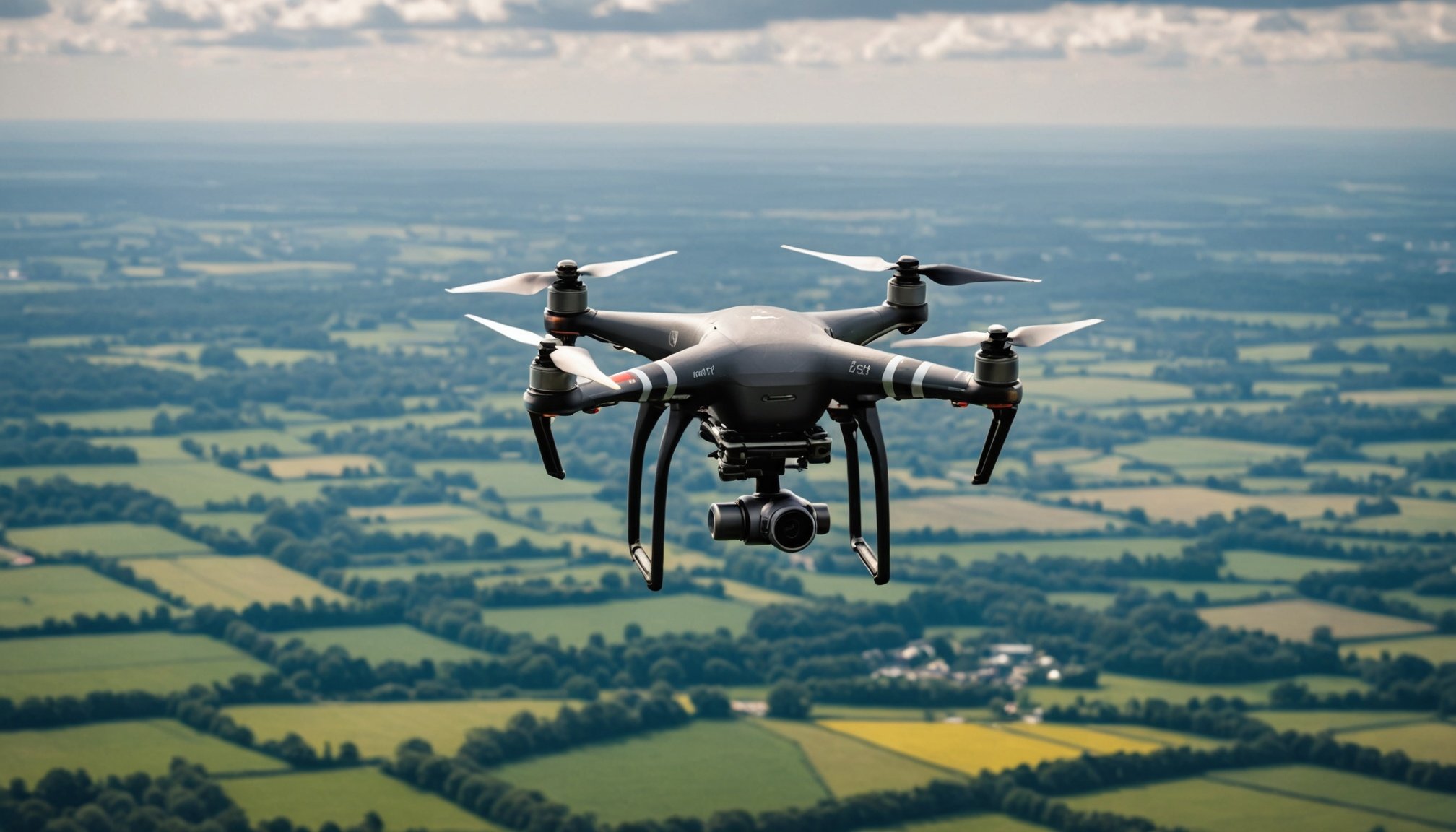Overview of UK Drone Laws
Navigating UK drone regulations is essential for both hobbyists and professional drone operators. Legal requirements are primarily dictated by the Civil Aviation Authority (CAA), which oversees the rules governing drone use to ensure safety and compliance. These regulations are designed to prevent disruptions and maintain order in the skies, making them crucial for anyone flying drones in the UK.
The CAA regulations specify that drone operators must adhere to strict airspace rules. This includes maintaining a safe distance from airports, people, and private property, as well as flying below an altitude of 400 feet. Importantly, the airspace rules help mitigate the risk of interference with other aircraft and ensure public safety.
Licensing and registration form a key component of operating drones legally. Operators of drones weighing 250 grams or more are required to register with the CAA and pass a theory test to obtain a Flyer ID. Additionally, if flying for commercial purposes, obtaining an Operational Authorisation is mandatory. Understanding these licensing requirements ensures compliance with UK laws and protects operators from potential penalties.
Through these measures, the UK maintains a structured system to responsibly manage drone activities within its airspace.
Consequences of Illegal Drone Use
Illegal drone operation can lead to serious legal repercussions. When individuals engage in unauthorised drone flights, they may face potential criminal charges. These can range from misdemeanours to felonies, impacting one’s criminal record. To guard against these charges, compliance with aviation rules is essential.
Penalties for violations include hefty fines. The exact amount typically depends on the severity and nature of the breach. For instance, repeating offences or interfering with commercial aircraft can result in significantly increased consequences. Such fines serve as a crucial deterrent against negligent behaviour and ensure safety and privacy are maintained.
For commercial operators, illegal drone usage can incur long-term consequences beyond immediate penalties. It may include the suspension or revocation of licences, hampering their business operations. Furthermore, commercial entities facing repeated violations might suffer damage to their professional reputation as well, impacting client trust.
Ensuring drones are operated legally is crucial to avoiding these negative outcomes. By adhering to established regulations, operators protect themselves from the severe repercussions associated with illegal drone flights. Proper licensing and awareness can aid in maintaining compliance, ultimately safeguarding both personal and commercial interests.
Case Studies of Illegal Drone Use
When discussing case studies of illegal drone use, high-profile drone incidents in the UK reveal much about the landscape of regulation and enforcement. One such incident involved a drone disrupting flights at Gatwick Airport in December 2018, resulting in significant delays and affecting around 140,000 passengers. This incident illuminated potential security risks and prompted a wider discussion on regulatory measures.
Legal Examples
Legal examples following such incidents often showcase the penalties imposed. For instance, in the Gatwick case, authorities arrested two individuals suspected of flying the drones. Although they were later released without charge, the incident led to the implementation of stricter laws and legal frameworks surrounding drone operations. Under these laws, unauthorised drone flights could result in fines or even imprisonment.
Examining these case studies offers insightful lessons for drone operators. These legal examples stress the importance of adhering to flight regulations to avoid penalties. Moreover, they highlight the need for updated safety protocols and legislation. By learning from these incidents, drone operators can better navigate the complex legal landscape and ensure compliance with the law. Understanding these case studies equips operators with knowledge, encouraging safer and more responsible drone usage.
Safety Concerns Associated with Illegal Drone Use
Unauthorized drone flights pose significant risks to public safety. When drones operate in restricted areas, such as near airports or densely populated spaces, they can jeopardize aircraft safety. Airspace violations can lead to collisions with emergency service aircraft, causing disruption and potentially catastrophic incidents during critical operations.
No-fly zones are established to protect sensitive areas and ensure drone safety. These zones are crucial for maintaining order in the airspace, preventing accidents, and ensuring privacy. Violations of these zones by illegal drone use not only endanger others but can also lead to severe legal repercussions for operators.
Airspace violations disrupt the coordination of emergency services, such as police helicopters and fire-fighting aircraft. An unauthorized drone sighting often forces these services to halt or divert their activities, delaying response times during emergencies. This interruption could mean the difference between life and death in critical situations.
To mitigate these safety concerns, drone users should commit to understanding and respecting regulations. They must ensure their operations do not compromise public safety or conflict with emergency operations. Adhering to guidelines and recognizing the importance of no-fly zones will ultimately protect both people and property.
Practical Advice for Responsible Drone Operation
Responsible drone use begins with adherence to UK regulations. It’s crucial to familiarize yourself with current rules to ensure compliance. Always check the Civil Aviation Authority (CAA) guidelines before flying. These rules outline the best practices for safe drone operation, such as maintaining a safe distance from people and property and avoiding restricted zones.
To ensure compliance, consider these steps:
- Register your drone if it exceeds 250 grams.
- Obtain the necessary permissions for commercial drone activities.
- Stay within the prescribed height limits and avoid no-fly zones.
Safe flying practices are essential to prevent accidents and disruptions. Keep your drone within line of sight at all times, and be conscious of weather conditions, as suitable flying environments are vital for safety. Respect others’ privacy by avoiding overflight of homes and private areas.
Remaining informed about changes in drone laws can be challenging. Utilize resources like the CAA’s online updates and community forums dedicated to responsible drone use. These platforms offer valuable insights and ensure you stay compliant and well-informed as a drone operator.
Summary of Regulatory Guidelines
Navigating regulatory guidance is crucial for safe drone operation and maintaining compliance standards. The CAA (Civil Aviation Authority) provides a comprehensive framework that outlines the key regulatory guidelines, ensuring all drone operators adhere to these rules.
A critical component of regulatory guidance is the understanding of airspace categories. Airspace is divided into different categories, each with specific rules for drone operation. Understanding these categories is fundamental for compliance standards. For instance, some zones may have restrictions or require special permissions for flying drones.
Tools and apps are valuable resources for checking airspace restrictions before embarking on a flight. These applications can provide real-time updates on airspace conditions and help drone pilots identify restricted areas, ensuring they avoid potential legal issues.
By equipping themselves with the knowledge of regulatory guidance and making use of available tools, drone operators can ensure they operate within compliance standards, safeguarding both their activities and the safety of the airspace. This proactive approach is essential, promoting responsible drone usage and preventing inadvertent infringements on restricted areas.
Overview of Drone Regulations in the UK
Understanding the UK drone laws is crucial for anyone keen on flying drones. The current legislative framework aims to ensure safety for both drone operators and the public. The legal framework is primarily governed by the Civil Aviation Authority (CAA), which is the key regulatory body overseeing drone use in the UK.
Under the current drone regulations, all drone operators must register with the CAA and take an online test to acquire a flyer ID. This ensures that operators are aware of safety guidelines, such as keeping drones within sight and not flying above 400 feet. Compliance with these laws is essential to prevent accidents and maintain public safety.
The importance of adhering to these regulations cannot be overstated. Non-compliance can result in severe penalties, including fines. Safety and privacy are at the heart of the UK drone laws, thus protecting not only airspace but also individuals’ privacy is a priority. As drone technology continues to evolve, staying informed about legislative changes is key to operating within the law. Understanding and following the legal framework contributes to responsible and safe drone usage.
Penalties for Illegal Drone Use
In the realm of unmanned aerial vehicles, otherwise known as drones, it’s critical to understand the drone penalties and their potential ramifications. With the rise in drone popularity, legal frameworks have become stringent, aiming to mitigate risks and ensure safe operation. Violation of regulations can attract various legal consequences ranging from fines to severe criminal charges.
Typically, fines serve as the most common enforcement measure for minor infractions. These penalties can reach significant sums, depending on the severity and nature of the violation. When it comes to serious breaches, like flying in no-fly zones or near airports, the law steps up with harsh penalties, potentially including imprisonment.
Criminal charges could be issued for breaches that endanger public safety, privacy violations, or damage to property. These charges not only lead to costly fines but also damaging criminal records. For example, a notable case involved a drone operator who ignored airspace restrictions and interfered with airport operations. This transgression resulted in heavy penalties and highlighted the importance of following drone regulations.
Enforcing these rules is vital to maintain order and safety in our skies. As drone use grows, so do the responsibilities of drone operators to adhere to set guidelines diligently.
Safety Risks Connected with Illegal Drone Operations
Airspace safety is increasingly jeopardized by unauthorized drone flights, posing significant safety concerns. Drones illegally entering restricted areas or flying at inappropriate altitudes can disrupt operations and create hazardous situations for manned aircraft. Instances of these disruptions have led to near-misses, requiring urgent risk assessment strategies to mitigate potential accidents.
One notable problem is that unauthorized drone operations can interfere with emergency response efforts. Both the public and emergency services can be endangered when drones cross paths with helicopters or planes performing critical tasks. This raises profound safety concerns for all traditional aviation stakeholders who rely on clear skies to perform their duties safely and efficiently.
Addressing these dangers requires a robust approach to airspace management. Recommendations for enhancing airspace safety include the development of stricter no-fly zones for drones and implementing advanced technologies to detect and neutralize unauthorized flights. Collaborating with drone manufacturers to incorporate geo-fencing technology could offer a proactive solution, keeping drones out of forbidden areas. Furthermore, increasing public awareness about the repercussions of illegal drone use will educate and dissuade potential violators. These measures, if appropriately executed, can significantly reduce the risk assessment burden, ensuring safer skies for everyone.
Legislative Changes and Future Trends
The world of drone operation never stands still, and keeping pace with drone law updates is crucial for compliance and innovation. Recent legislative changes have focused on enhancing safety, privacy, and accountability. Regulations now require drone operators to register their devices and adhere to strict no-fly zones, particularly near airports and densely populated areas.
Anticipated future regulations are expected to further refine airspace management and integrate advanced technologies. Upcoming changes might include mandatory remote identification systems, enabling authorities to identify drones in real time. Such systems not only increase security but also facilitate smoother integration of drones into shared airspace.
Staying informed on these evolving regulations is critical for all drone users. Awareness ensures compliance and encourages responsible usage, which promotes public trust in drone technology. Engaging with future regulations early allows operators to adapt practices promptly, avoiding potential penalties while maximizing opportunities.
The importance of staying informed cannot be overstated. Proactively understanding legislative changes empowers operators to innovate within legal boundaries. This proactive approach supports the sustainable growth of the drone industry, leveraging technological advances while maintaining safety and privacy standards.
Best Practices for Legal Drone Operation
Navigating the skies requires adherence to specific legal drone use protocols. By understanding these compliance tips and operating guidelines, operators can ensure safe and lawful flights.
Understanding Restricted Areas
Drone operators must be aware of no-fly zones and restricted airspace. Identifying these regions involves checking current maps and resources to ensure that privacy and property rights are respected. Failing to observe restrictions can lead to legal consequences and impact individuals’ privacy. Awareness of local and national airspace regulations is crucial in maintaining compliance.
License and Registration Requirements
Drone operation necessitates certain certifications. Operators must often undergo a process to obtain the necessary licenses, ensuring they understand the technical and safety aspects of drone control. In addition to certification, drones typically require registration, a simple process that involves submitting details about the drone’s make, model, and intended use to a regulatory body.
Resources for Drone Operators
To support drone operators, a variety of online tools and applications are available, aiding in compliance with regulations. Moreover, recommended organizations and forums offer platforms for operators to exchange advice and information. These resources serve as valuable assets in navigating the evolving world of drone operation.











